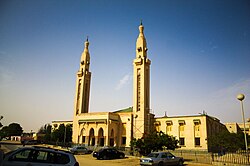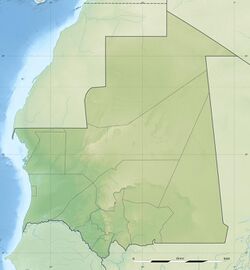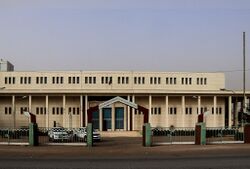Place:Nouakchott
Nouakchott
| |
|---|---|
Capital city | |
From the top to bottom-right, View of the City, Saudi Mosque, Société Nationale Industrielle et Minière Tower, Presidential Palace, Avenue Genéral du Gaulle City view of Nouakchott | |
| Coordinates: [ ⚑ ] : 18°05′09″N 15°58′43″W / 18.08581°N 15.9785°W[1] | |
| Country | |
| Capital district | Nouakchott |
| Government | |
| • Council president | Fatimatou Abdel Malick |
| Area | |
| • Total | 1,000 km2 (400 sq mi) |
| Elevation | 7 m (23 ft) |
| Population (2019 census) | |
| • Total | 1,195,600 |
| • Density | 1,200/km2 (3,000/sq mi) |
| Website | {{{1}}} |
Nouakchott (/nwækˈʃɒt, nwɑː-/; French: [nwakʃɔt]; Arabic: نواكشوط; Berber: Nwakcoṭ, originally derived from Berber: Nawākšūṭ, "place of the winds")[2] is the capital and largest city of Mauritania. Located in the southwestern part of the country, it is one of the largest cities in the Sahara.[3] The city also serves as the administrative and economic center of Mauritania.
Once a mid-sized coastal village, Nouakchott was selected as the capital for the nascent nation of Mauritania. It was originally designed and built to accommodate a population of 15,000, but experienced significant population growth in the 1970s when many Mauritanians fled their home villages due to drought and increasing desertification. Many of the newcomers settled in slum areas of the city that were poorly maintained and extremely overcrowded. By the mid-1980s, Nouakchott's population was estimated to be between 400,000 to 500,000.[4]
(As of 2019), the city had a population of nearly 1.2 million people and serves as the hub of the Mauritanian economy. It is home to a deepwater port and Nouakchott–Oumtounsy International Airport, one of the country's two international airports. It also hosts the University of Nouakchott and several other more specialized institutions of higher learning.
History
Nouakchott was a large, fortified fishing village (ksar) in pre-colonial times and under French rule. As Mauritania prepared for independence, it lacked a capital city. The area of present-day Nouakchott was chosen by Moktar Ould Daddah, the first President of Mauritania, and his advisors. Ould Daddah desired the new capital to symbolise modernity and national unity, which ruled out existing cities or towns in the interior. The village was selected as the capital city for its central location between Saint-Louis, Senegal, the city from which the colony of Mauritania was governed, and Nouadhibou. Its location also meant that it avoided the sensitive issue of whether the capital was built in an area dominated by the Arabs, Amazigh (Berbers) or Sub-Saharan Africans.[5]:369
Construction began in March 1958 to enlarge the village to house a population of 15,000, and the basics were completed by the time that the French granted independence on 28 November 1960.[6] Nouakchott was planned with the expectation that commerce and other economic activities would not take place in the city. Nouakchott's central business district was planned with broad streets and a grid-like structure; the new Cinquième Quartier (Fifth District) was located close to this area and became the location of a large open-air market and residential area within a few years. During the 1960s, the city obtained its own local government. By the 1970s, these new areas had grown so much that they replaced the old ksar in terms of importance, as they also hosted the governmental buildings and state enterprises.[5]:369
The city was attacked twice in 1976 by the Polisario Front during the Western Sahara conflict, but the guerrillas caused little damage. The city has had massive and unconstrained growth, driven by the North African drought, since the beginning of the 1970s; hundreds of thousands moved there in search of a better life. The official censuses showed 134,000 residents in 1977 and 393,325 in 1988, although both figures were probably smaller than reality.[5]:370 The population is now estimated to consist of at least one third of the country's population of 3.2 million,[7] and the 2013 census showed a population of 958,399.[8]
Geography

Located on the Atlantic coast of the Sahara Desert, it lies on the west coast of Africa. With the exception of Friendship Port and a small fishing port, the coastal strip is mostly left empty and allowed to flood. The coastline includes shifting sandbanks and sandy beaches. There are areas of quicksand close to the harbor.[9] Nouakchott is largely flat and only a few meters above sea level. It is threatened by the sand dunes advancing from its eastern side which pose a daily problem.[10] There have been efforts to save particular areas, including work by Jean Meunier.[11]:168 Owing to the rapid build-up, the city is quite spread out, with few tall buildings. Most buildings are one-story.[12]
Nouakchott is built around a large tree-lined street, Avenue Gamal Abdel Nasser, which runs northeast through the city centre from the airport. It divides the city into two, with the residential areas in the north and the medina quarter, along with the kebbe, a shanty town formed due to the displacement of people from other areas by the desert.[13]:50–57 Other major streets are named (in French) for notable Mauritanian or international figures of the 1960s: Avenue Abdel Nasser, Avenue Charles de Gaulle, Avenue Kennedy, and Avenue Lumumba, for example.[14]
The kebbe consists of cement buildings that are built overnight and made to look permanent to avoid destruction by the authorities. In 1999, it was estimated that more than half of the city's inhabitants lived in tents and shacks, which were used for residential as well as business purposes.[15] The city is broken into nine arrondissements, sub-divided into alphabetised Îlots. These are Teyarett, Ksar, Tevragh Zeïna, Toujournine, Sebkha, El Mina, Dar Naïm, Arafat and Riad. The Sebkha (Cinquième) Arrondissement is home to a large shopping area.[14]:116−17
Climate
Nouakchott features a hot desert climate (Köppen: BWh) with hot temperatures throughout the year but cool winter night temperatures. Due to the city's oceanside location, Nouakchott is generally not quite as hot as other cities with this climate. Still, the city can experience sweltering days. While average high temperatures are relatively constant at around 33 °C (91 °F), average low temperatures can range from 25 °C (77 °F) during the summer months to 13 °C (55 °F) during the winter months. Minimum temperatures can be as low as 10 °C (50 °F) during winter nights in Nouakchott. Average rainfall in the city is 95 mm (3.7 in) a year.[16]
Script error: No such module "weather box".
Climate change
A 2019 paper published in PLOS One estimated that under Representative Concentration Pathway 4.5, a "moderate" scenario of climate change where global warming reaches ~2.5–3 °C (4.5–5.4 °F) by 2100, the climate of Nouakchott in the year 2050 would most closely resemble the current climate of Khartoum. The annual temperature would increase by 2.3 °C (4.1 °F), and the temperature of the warmest month by 2.8 °C (5.0 °F), while the temperature of the coldest month would decrease by 0.3 °C (0.54 °F).[17][18] According to Climate Action Tracker, the current warming trajectory appears consistent with 2.7 °C (4.9 °F), which closely matches RCP 4.5.[19]
Sustainability
Responding to a 450% projected increase in electricity demand between 2010 and 2030, Nouakchott's Sheikh Zayed solar power plant was completed in 2012 and is considered the largest solar power plant in Africa.[20] The desert climate causes dust accumulation, which negatively impacts the performance of photovoltaic solar panels.[21]
Government
Nouakchott is divided into three administrative regions (wilayat) led by governors appointed by the central government, each of which contains three departments (moughataa):
- Nouakchott-Nord (Nouakchott-North): Dar-Naim, Teyarett, Toujouonine
- Nouakchott-Ouest (Nouakchott-West): Ksar, Sebkha, Tevragh-Zeina
- Nouakchott-Sud (Nouakchott-South): Arafat, El Mina, Riyad
Separate from the wilayat, a directly elected regional council was established in Nouakchott in 2018, which took over the roles of promoting social and economic development from the Urban Community that it replaced. Fatimatou Abdel Malick was elected council president in September 2018.[22]
Nouakchott was initially divided into four departments in 1973. In 1986 the current nine departments were created.[23]
Formerly a district, in 1990 Nouakchott became a region of Mauritania.[24] On 25 November 2014, it was split into the three current regions,[25] with the previous governor of Nouakchott Mahi Ould Hamed becoming the first governor of Nouakchott-Nord.[26]
Demographics
| Historical population | ||
|---|---|---|
| Year | Pop. | ±% |
| 1961 | 5,807 | — |
| 1965 | 15,000 | +158.3% |
| 1970 | 25,000 | +66.7% |
| 1977 | 134,704 | +438.8% |
| 1981 | 232,000 | +72.2% |
| 1988 | 393,325 | +69.5% |
| 2000 | 558,195 | +41.9% |
| 2013 | 958,399 | +71.7% |
| 2019 | 1,195,600 | +24.7% |
For comparison, its population was only 20,000 in 1969. Part of the difficulty in estimating the city's population is that part of it is nomadic, setting up tents in suitable locations, then packing up when the need strikes. Some estimates put the 2008 population at over 2 million.[7] The 2013 census gave the city's population as 958,399.[8]
Slum resettlement
In 2009, the government of Mauritania announced that it would begin a process of clearing the slum on the outskirts of Nouakchott, as 24,000 families would eventually be relocated to planned housing in the city. The process was scheduled to begin with the relocation of 9,000 families from the outskirts into the poor Arafat department neighborhood of "Kosovo", popularly named for its high crime rate and poor services. The government planned to begin moving families in June 2009, despite concerns from aid agencies that needed infrastructure could not be put in place in the receiving neighborhood.[27] In 2013, it was reported that "slums have been replaced by social dwellings for the poorest",[28] with the World Bank reporting that the plan met with substantial success, resulting in access to improved services for 181,035 people in the slum areas.[29]
Economy
Nouakchott is the center of the Mauritanian economy, with three-quarters of service sector enterprises located in the city (As of 1999) with 90% of the city's economic activity consisting of informal transactions. Some inhabitants have multiple addresses and maintain strong ties with their regions of origin, at times returning for labor.[15]
Transport
Nouakchott has a Chinese-built deepwater port that opened in 1986. It was designed for a capacity of 500,000 tons deadweight (DWT) of cargo a year, but has been handling 1,500,000 tons (DWT) by 2009.[9] China agreed in 2009 to invest US$282 million in the port, aiming to extend the main quay by over 900 m (3,000 ft).[30] As of 2011, the World Bank was investigating funding a new shipping container facility at the port.[31]
Air service is provided by Nouakchott–Oumtounsy International Airport, which replaced the previous Nouakchott International Airport in June 2016.[32]
The Cairo–Dakar Highway leg from Nouakchott to Nouadhibou was paved in 2004, although the Nouakchott-Rosso leg was paved before independence.[33] A 1,100-kilometre (680 mi) road (Route d'Espoir (Road of Hope)) connects the city with Néma via Boutilimit and Kiffa.[34]:235 In the city, there is a public transport and commuter system, with vehicles serving major boulevards.[15]
In July 2022 a tramway project was presented, without a scheduled opening date.[35]
Education
The city is home to the University of Nouakchott Al Aasriya, the main university in Mauritania, opened in 1981. As of 1995, it had 70 professors and 2,800 students.
Other higher education facilities include the Lebanese International University of Mauritania, the National School of Administration, the College of Science and Technology and the Higher Scientific Institute.[34]:105
There are many primary and secondary schools, among the most prominent are the American International School of Nouakchott[36] and the Lycée Français Théodore Monod.[37]
Culture
Attractions in Nouakchott include the National Museum of Mauritania, the National Library and the National Archives.[38] The city hosts several markets, including the Marocaine market and the beaches. One beach is devoted to fishing boats where fish can be bought fresh at the Fish market. Nouakchott is a principal selling place of native Saharan meteorites.[39]
Places of worship
Among the places of worship, they are predominantly Muslim mosques.[40] There are also Christian churches and temples: Roman Catholic Diocese of Nouakchott (Catholic Church), Protestant churches, Evangelical Churches.
Sport
Nouakchott hosts six of the fourteen teams of the Mauritanian Premier League.
Twin towns – Sister cities
Nouakchott is twinned with:
See also
- List of cities in Mauritania
- Transport in Mauritania
References
- ↑ [[[:Template:Geonameslink]] Nouakchott, Mauritania] in [[[:Template:Geonamesabout]] Geonames.org (cc-by)]
- ↑ Lorenz, Ralph D.; Zimbelman, James R. (2014). Dune Worlds: How Windblown Sand Shapes Planetary Landscapes. Heidelberg: Springer Science & Business Media. ISBN 978-3-540-89725-5. https://books.google.com/books?id=-AO7BAAAQBAJ&pg=PA273. Retrieved 2016-07-10. page 273.
- ↑ "The Sahara: Facts, Climate and Animals of the Desert". http://www.livescience.com/23140-sahara-desert.html.
- ↑ Handloff, Robert E. (1990). Mauritania: A Country Study. Federal Research Division. pp. 50. ISBN 9780160197970.
- ↑ 5.0 5.1 5.2 Pazzanita, Anthony G. (2008). Historical Dictionary of Mauritania. Lanham, Maryland: Scarecrow Press. ISBN 978-0-8108-6265-4.
- ↑ Britannica, Nouakchott Nouakchott, britannica.com, USA, accessed on July 7, 2019,
- ↑ 7.0 7.1 "Nouakchott Travel Guide". http://www.world66.com/africa/mauritania/nouakchott.
- ↑ 8.0 8.1 "Mauritania: Regions, Cities & Urban Localities - Population Statistics in Maps and Charts". https://citypopulation.de/Mauritania-Cities.html.
- ↑ "Nouakchott, Mauritania : Image of the Day" (in en). 9 January 2001. http://earthobservatory.nasa.gov/IOTD/view.php?id=6234.
- ↑ Welland, Michael (2009). Sand: The Never-ending Story (1. ed.). Berkeley: University of California Press. ISBN 9780520254374. https://archive.org/details/isbn_9780520254374.
- ↑ Spasevski, +Jugoslav (2013-09-29). "Nouakchott, Mauritania" (in en-US). https://www.tourist-destinations.com/2013/09/nouakchott-mauritania.html.
- ↑ de Valicourt, Benedict (2000). Mauritanie. Paris: Editions Marcus. ISBN 9782713101533. https://books.google.com/books?id=9Z6asvXDSPcC&q=avenue+gamal+abdel+nasser+nouakchott&pg=PA52.
- ↑ 14.0 14.1 Hudgens, Jim; Trillo, Richard (2003). Rough Guide to West Africa (4th ed.). London: Rough Guides. ISBN 1843531186. https://archive.org/details/roughguidetowest0000hudg.
- ↑ 15.0 15.1 15.2 Lawrence, William. "Symptom of Crisis or Engine of Development? The Mauritanian Informal Economic Sector". The Fletcher Journal of Development Studies. http://fletcher.tufts.edu/~/media/Fletcher/Microsites/praxis/xv/Lawrence.pdf.
- ↑ 16.0 16.1 "Klimatafel von Nouakchott / Mauretanien" (in de). Baseline climate means (1961–1990) from stations all over the world. Deutscher Wetterdienst. https://www.dwd.de/DWD/klima/beratung/ak/ak_614420_kt.pdf.
- ↑ Bastin, Jean-Francois; Clark, Emily; Elliott, Thomas; Hart, Simon; van den Hoogen, Johan; Hordijk, Iris; Ma, Haozhi; Majumder, Sabiha et al. (10 July 2019). "Understanding climate change from a global analysis of city analogues". PLOS ONE 14 (7): S2 Table. Summary statistics of the global analysis of city analogues.. doi:10.1371/journal.pone.0217592. PMID 31291249. Bibcode: 2019PLoSO..1417592B.
- ↑ "Cities of the future: visualizing climate change to inspire action". Current vs. future cities. https://crowtherlab.pageflow.io/cities-of-the-future-visualizing-climate-change-to-inspire-action.
- ↑ "The CAT Thermometer". https://climateactiontracker.org/global/cat-thermometer/.
- ↑ El Hacen Jed, Mohamed; Ihaddadene, Razika; Ihaddadene, Nabila; Elhadji Sidi, Cheikh ELBanany; EL Bah, Menny (2020-03-01). "Performance analysis of 954,809 kWp PV array of Sheikh Zayed solar power plant (Nouakchott, Mauritania)" (in en). Renewable Energy Focus 32: 45–54. doi:10.1016/j.ref.2019.11.002. ISSN 1755-0084. https://www.sciencedirect.com/science/article/pii/S1755008419302157.
- ↑ Lasfar, Sara; Haidara, Fanta; Mayouf, Chiva; Abdellahi, Fatimatou Med; Elghorba, Mohamed; Wahid, Achraf; Kane, Cheikh Sid Ethmane (2021-08-01). "Study of the influence of dust deposits on photovoltaic solar panels: Case of Nouakchott" (in en). Energy for Sustainable Development 63: 7–15. doi:10.1016/j.esd.2021.05.002. ISSN 0973-0826. https://www.sciencedirect.com/science/article/pii/S0973082621000569.
- ↑ "La Région de Nouakchott" (in fr). International Association of Francophone Regions (fr). 1 July 2020. http://www.regions-francophones.org/actualite/2438/5606-la-region-de-nouakchott.htm.
- ↑ "Actualité du dimanche 01juillet 2001". Ami.mr. http://www.ami.mr/fr/bulletin20010701.htm.
- ↑ Law, Gwillim. "Regions of Mauritania". http://www.statoids.com/umr.html.
- ↑ "Mauritanie: la capitale Nouakchott, sera découpée en trois wilayas". Alakhbar. 26 November 2014. http://fr.alakhbar.info/9671-0-Mauritanie-la-capitale-Nouakchott-sera-decoupee-en-trois-regions.html.
- ↑ "Les trois wali de Nouakchott connus". le calame. 12 December 2014. http://lecalame.info/?q=node/1184.
- ↑ "City versus slum". 31 March 2009. http://www.irinnews.org/report.aspx?ReportID=83724.
- ↑ "The City of Nouakchott – Perspectives and Challenges". EcoMENA. http://www.ecomena.org/tag/slums/.
- ↑ "Implementation Completion Report (ICR) Review - Urban Development Program". World Bank. http://lnweb90.worldbank.org/oed/oeddoclib.nsf/DocUNIDViewForJavaSearch/8525682E0068603785257B3D00720810?opendocument.
- ↑ "China to Invest US$282 Million in Nouakchott Port Expansion - Dredging News Online". http://www.sandandgravel.com/news/article.asp?v1=11604.
- ↑ "Mauritania - Port of Nouakchott Development Project". http://documents.worldbank.org/curated/en/250361468052152298/pdf/650800PID0MAUR0port0of0Nouakchott0rev.pdf.
- ↑ "Mauritanie : inauguration du nouvel aéroport international de Nouakchott" (in fr). Jeune Afrique. 27 June 2016. http://www.jeuneafrique.com/337110/economie/mauritanie-inauguration-nouvel-aeroport-international-de-nouakchott/.
- ↑ Steck, Benjamin. "West Africa Facing the Lack of Traffic Lanes: A Study Case: The Nouakchott-Nouadhibou Road (Mauritania)". http://echogeo.revues.org/pdf/13101.
- ↑ 34.0 34.1 Pazzanita, Anthony G. (1996). Historical dictionary of Mauritania (2. ed.). Lanham, Maryland: Scarecrow. ISBN 0-8108-3095-7.
- ↑ "مذكرة تفاهم بإنشاء قطار في نواكشوط" (in ar). AlAkhbar.info. 2022-07-21. https://alakhbar.info/?q=node/41742.
- ↑ "American International School of Nouakchott". Aisnmauritania.com. http://aisnmauritania.com/.
- ↑ "Lycée Français Théodore Monod de Nouakchott, Mauritanie". Lftm-mr.net. http://lftm-mr.net/.
- ↑ Ham, Anthony (2006). West Africa (6th ed.). Footscray, Vic.: Lonely Planet. ISBN 1740597710. https://archive.org/details/westafrica00hama.
- ↑ "Nouakchott, Mauritania – "The Place of the Winds"". 11 September 2016. https://whatsthecapitalof.com/2016/09/11/nouakchott-mauritania-the-place-of-the-winds/.
- ↑ Britannica, Mauritania , britannica.com, USA, accessed on July 7, 2019
- ↑ "Twinnings and Agreements With Cities". http://www.madrid.es/portales/munimadrid/es/Inicio/Herramientas/English/Madrid-International?vgnextfmt=default&vgnextoid=97806a71fca62410VgnVCM1000000b205a0aRCRD&vgnextchannel=29367421ee261510VgnVCM2000000c205a0aRCRD&idCapitulo=7189053.
- ↑ "Amman's Relations with Other Cities". http://www.ammancity.gov.jo/english/relations/r12.asp.
- ↑ "List of Gansu's Sister Cities by 2012". http://gansu.chinadaily.com.cn/2013-10/24/content_17055490.htm.
Further reading
- Armelle Choplin et Riccardo Ciavolella, 2008. " Marges de la ville en marge du politique ? Logiques d’exclusion, de dépendance et d’autonomie à Nouakchott (Mauritanie) », Autrepart, n°45. (in French)
- Choplin A., 2006. Fabriquer des villes-capitales entre monde arabe et Afrique noire: Nouakchott (Mauritanie) et Khartoum (Soudan), étude comparée. Université Paris 1, 535 p. (in French)
- Choplin A., 2006. Le foncier urbain en Afrique: entre informel et rationnel, l’exemple de Nouakchott, Mauritanie, Les annales de géographie, n°647, pp. 69–91. (in French)
- Anne-Marie Frérot, Nouakchott, du puits nomade à la ville des pétroliers. Risques et représentations, Maghreb-Machrek, n°190, c. December 2006 – 2007. (in French)
- Philippe Tanguy, « L'urbanisation irrégulière à Nouakchott: 1960-2000 », Insaniyat, n°22, October - December 2003, (vol. VII, 4). (in French)
- Diagana I., 1993. Croissance urbaine et dynamique spatiale à Nouakchott, Thèse doct.: géographie: Lyon II, 314 p. (in French)
- Pitte J.-R., 1977. Nouakchott, capitale de la Mauritanie. Paris : Univ. de Paris-Sorbonne, p. 200. (in French)
- Mohamed Salem Ideidbi, Mauritanie : la Richesse d'une nation, Nouakchott, al-Manar, 2011.
External links
| Wikivoyage has a travel guide for Nouakchott. |
 |














